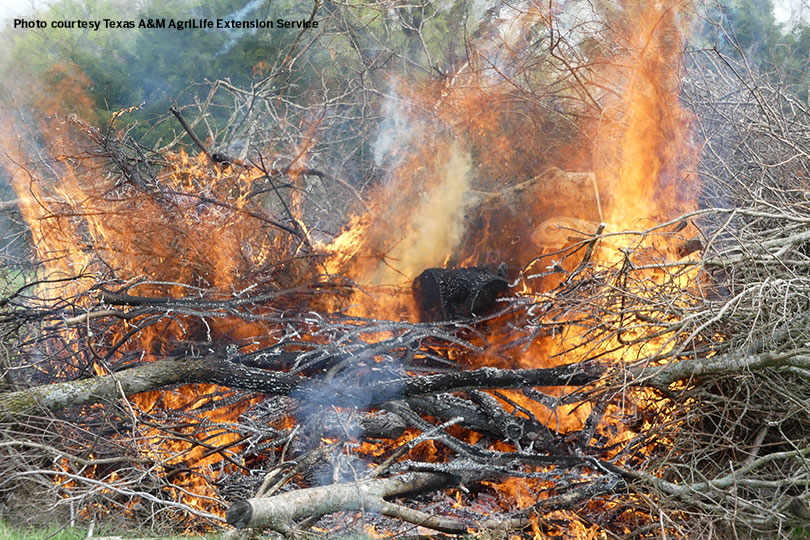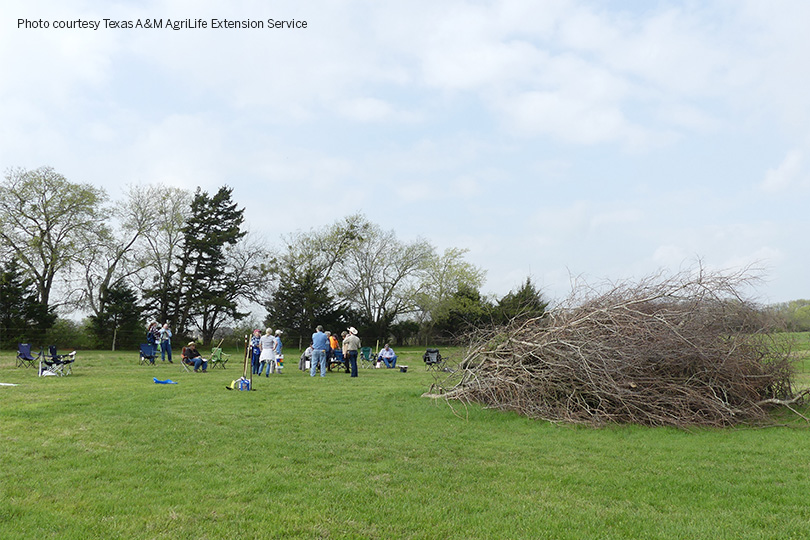By Jennifer Whitlock
Field Editor
When clearing brush from land, allowing small brush piles to remain in place for a short period can create optimal wildlife habitat.
The brush piles provide temporary habitat for a variety of birds and small mammal species, according to Chase Brooke, Texas A&M AgriLife Extension Service Agriculture and Natural Resources Extension agent in Collin County.
“Many landowners are looking to integrate wildlife management into their operations, and brush piles can be a very effective way of doing so, specifically for quail and other upland birds,” he said in an interview with Texas Farm Bureau Radio Network. “We’ve hosted a hands-on brush pile-building and burning demonstration to get people out in the field, show them different ways to build them and how to burn them safely at the end of their use.”
Smaller brush piles about 10 feet in diameter and 6 feet tall are the ideal size for this purpose.
Brooke recommends starting with larger tree trunks and limbs stacked in a “log cabin” pattern, then topped with leafy boughs and remaining small limbs.
The brush piles can act as “rest stops along the highway” as birds move from place to place.
For optimal quail habitat, he recommends spacing brush piles about 200 feet apart.
“You want to connect areas that they are foraging in and moving through,” he said. “Space those smaller piles about 150-200 feet apart to help them connect the dots as they move from point A to point B.”
Since the goal of clearing land and creating brush piles is to get rid of the brush by burning, Brooke reminded landowners not to place the piles too close to fences, under tree canopies or near diesel or fuel storage areas.
Deciding when to burn the piles depends on several factors, he noted.
“Over time, those brush piles are going to deteriorate, and that’s when you’ll start looking at burning them. Typically [when you burn brush], you won’t see huge exoduses of animals because even though there might be some animals living in it, that doesn’t necessarily mean they’re in there year-round,” he said. “It kind of comes down to the species of concern that you’re trying to manage for. Looking at birds, for example, if they’re nesting at a certain time of year, maybe wait until after that nesting period is over. The good thing is that most critters are well adapted. Once they notice fire is around, they get the memo, and they evacuate pretty quickly.”
Safety should always be the priority when burning brush. Weather conditions, wind patterns and county burn bans should be considered when deciding whether or not to burn a pile, but especially when burning several brush piles at once.
There are also regulations that must be followed, Brooke noted. Burning at night is prohibited and burning brush with winds less than six miles per hour (mph) or greater than 23 mph is likewise prohibited under Texas laws.
A little commonsense goes a long way in preventing out-of-control brush fires, he added.

“Don’t burn a pile without a way to put fires out. Have a small sprayer on hand or some shovels, just some way to help address anything that happens,” he said. “Because accidents happen. Maybe you light the brush pile, and it’s creeping along the grass around the mowed firebreak you put around it. If you have a shovel, you can walk over and put it out real quick or squirt a little water on it.”
Brooke is the co-author of a guide available through AgriLife, On-site Brush Pile Burning in Texas. The booklet is available here.
Another resource available from AgriLife is the Texas Prescribed Burning Handbook.


Great article, Thanks. Just to add, we look for low winds and after a rain.